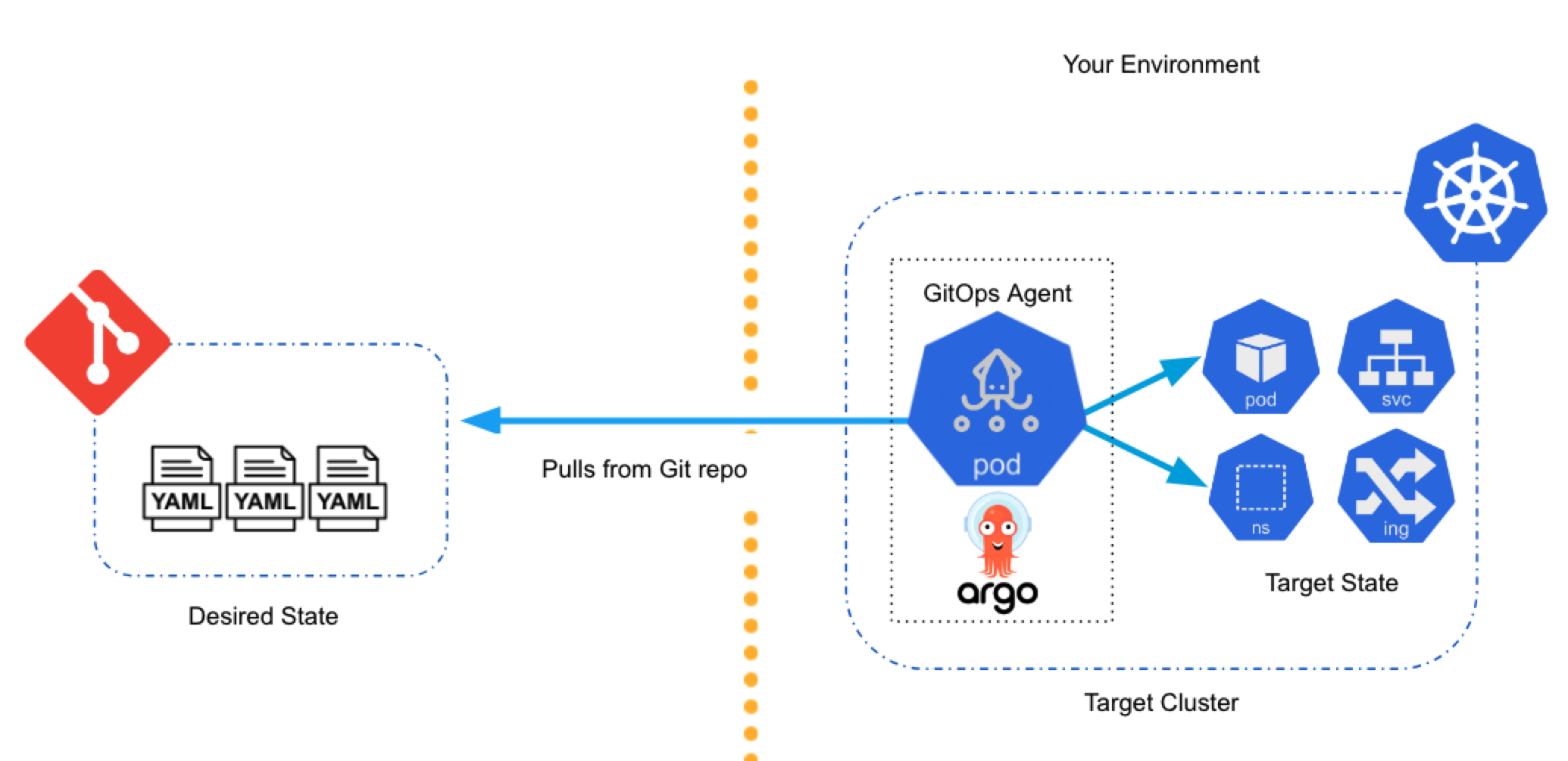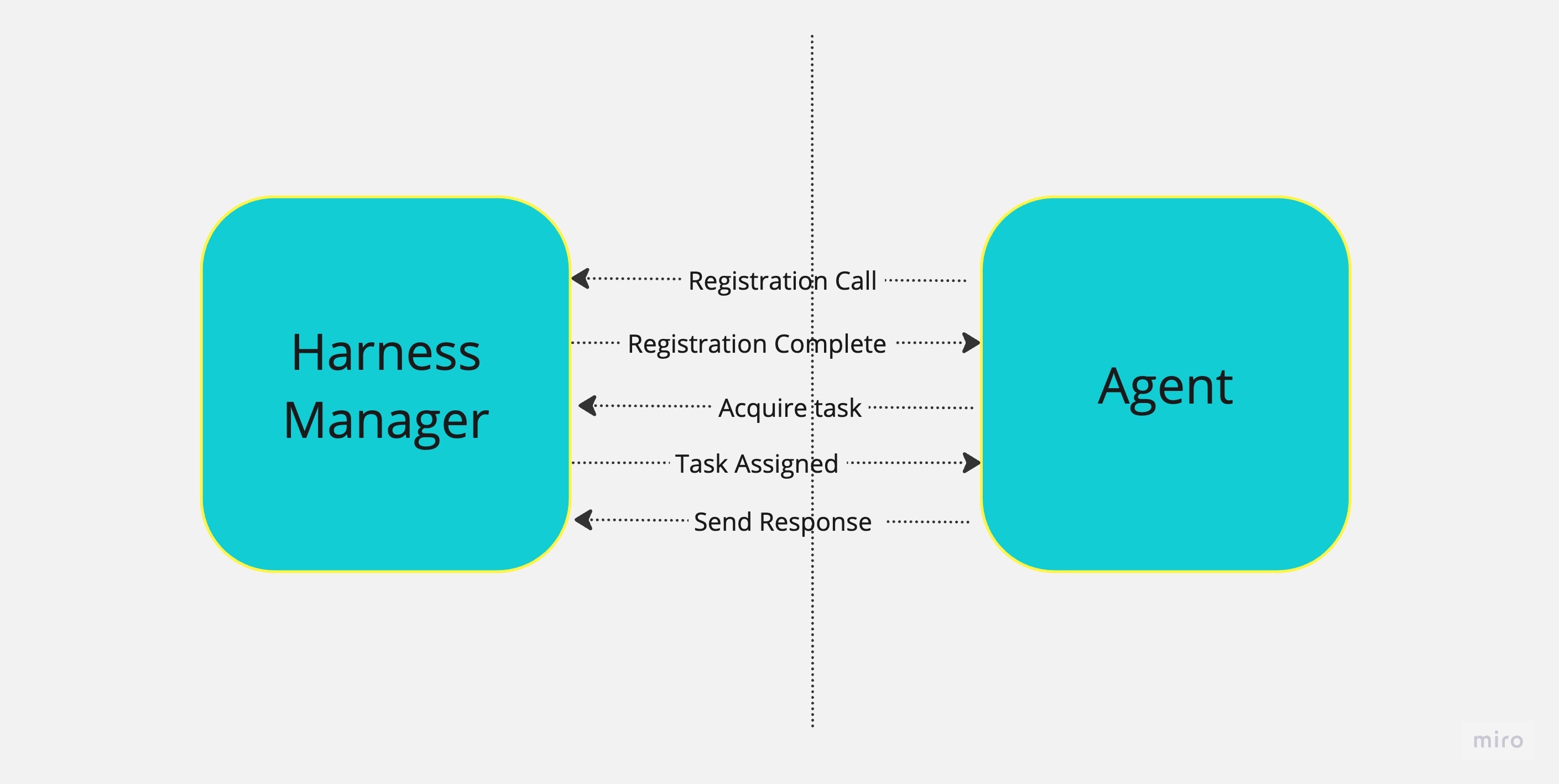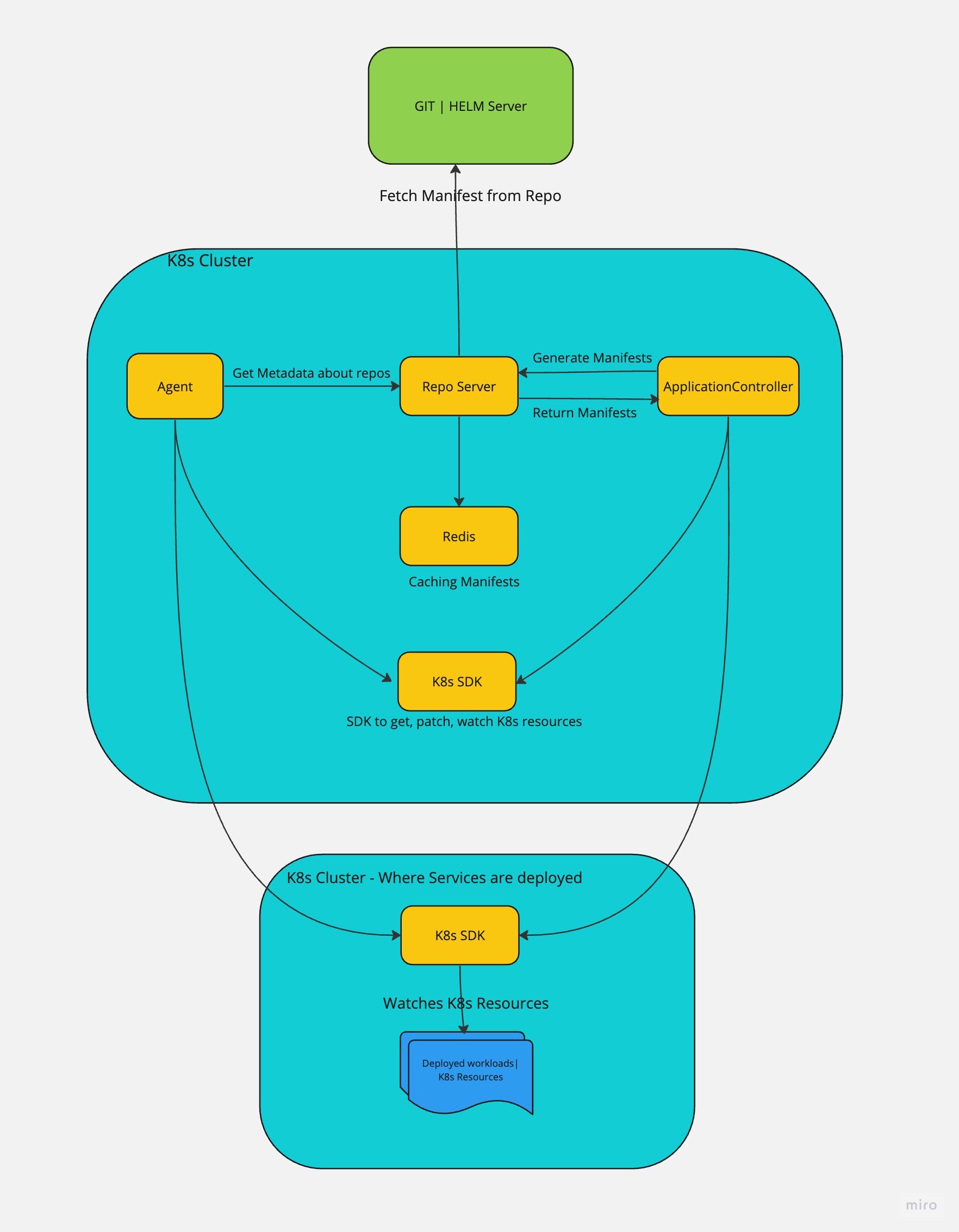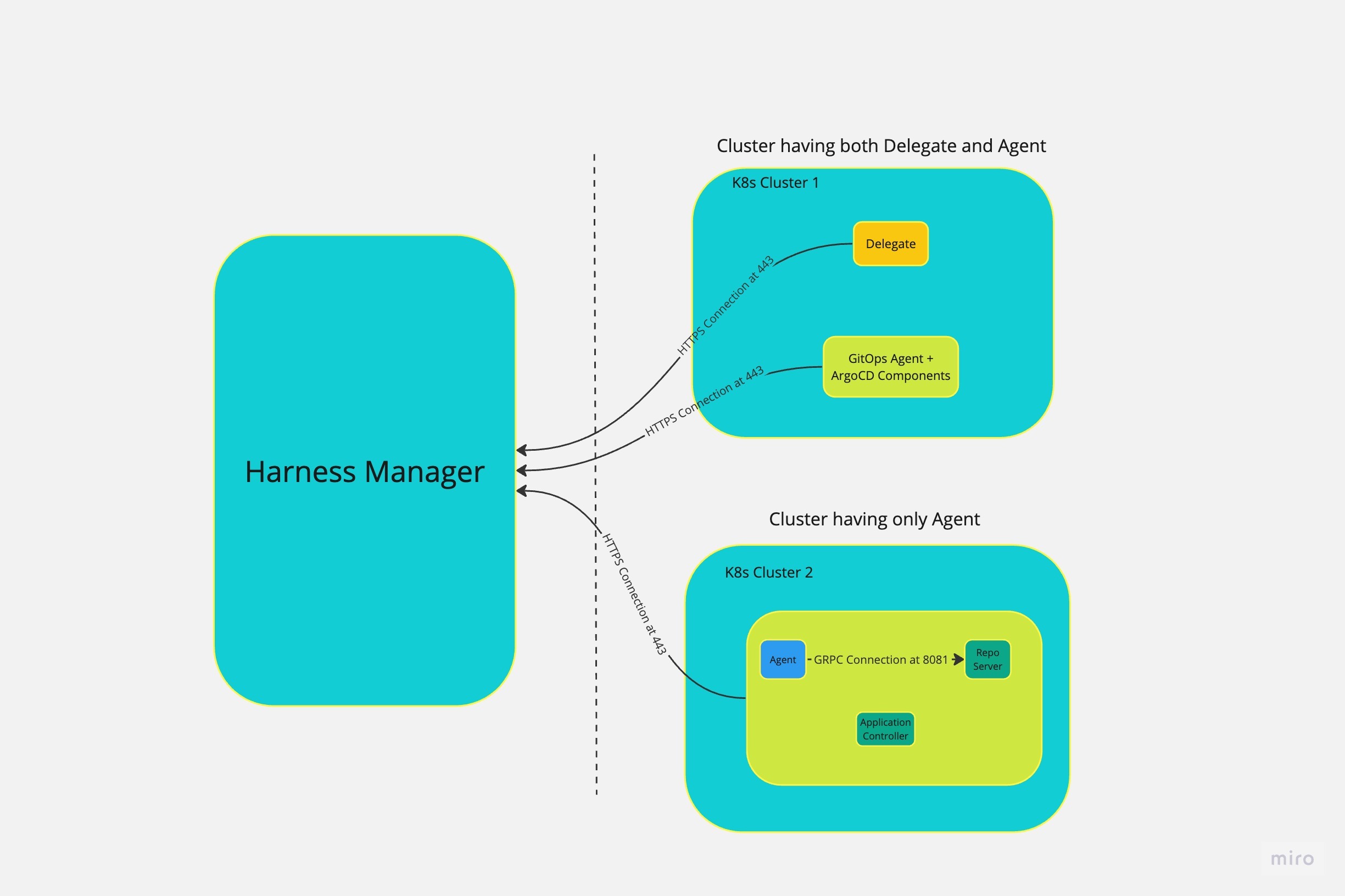Harness GitOps basics
This topic describes the basic concepts of Harness GitOps.
Harness GitOps lets you perform GitOps deployments in Harness. You define the desired state of the service you want to deploy in your Git manifest, and then use Harness GitOps to sync state with your live Kubernetes cluster.
Want to jump right in? Try the Harness CD GitOps Quickstart.
ArgoCD with Terraform Video Demo
Here's a quick demo showing how you can orchestrate cluster creation with Harness Infrastructure as Code Management, and use an Argo CD-based pipeline with Harness Continuous Delivery and GitOps.
This is a more advanced demo than a simple GitOps sync, but it shows how Harness integrates GitOps into common DevOps practices.
Harness GitOps Summary
What is GitOps? GitOps is simply using Git to perform Operations Team (Ops) tasks, such as building infrastructure, release automation, and orchestration.
GitOps is also a way to perform CD using Git as the source of truth for the desired state of the deployment. Architecturally, GitOps uses an operator of some kind to continuously monitor the desired state in Git and and sync it with the live state in the Kubernetes cluster.
In contrast to using Pipeline steps to perform deployments, GitOps automates deployments by syncing declarative specifications (your manifests) with your target environments. GitOps continually converges the target state (cluster) in accordance with the desired state (manifests). This method turns your deployed applications and infrastructures into fully-traceable, fully-versioned artifacts.
The declarative description can be in Kubernetes manifest, Helm Charts, Kustomize manifests, and so on.
The live state can be any microservice or application and its Kubernetes environment.
Here's a very simple diagram of the GitOps architecture:

The Harness GitOps Agent is a worker process installed in a Kubernetes cluster. The Agent can be installed in your target cluster or any cluster with connectivity to the target cluster.
Additionally, Harness offers a Hosted GitOps option that does not require you to deploy an Agent.
The Harness GitOps Application runs in Harness SaaS and is where you select the source and target resources to use and how to sync them.
The GitOps Agent makes outbound connections to the GitOps Application in Harness and the Git source repo.
The GitOps Agent then syncs the desired state of the source manifest with the live state of the cluster.
No Cluster-to-Git Push: in Harness GitOps, the Git manifest is always the source of truth. GitOps does not perform cluster reconciliation (or Self Heal), a process where changes made to the cluster are pushed to the Git source.
What Can I Deploy with Harness GitOps?
You can deploy any Kubernetes objects.
You can deploy services and infrastructure or just bootstrap infrastructure.
You can deploy an ApplicationSet and update it using a PR pipeline. See Harness GitOps ApplicationSet and PR Pipeline Tutorial.
Harness Platform Integration
Harness GitOps takes advantage of all the Harness platform features, such as Access Control, REST APIs, monitoring, auditing, etc.
The Harness GitOps Agent runs in your environment, but the remaining GitOps features are run in Harness SaaS. You do not need to devote resources to running a frontend for administration or dashboards and Harness manages backend resources other than the Agent.
GitOps vs Config-as-Code vs Harness Git Experience
Harness has multiple Git-based features and it's important to understand the differences:
- GitOps: used for deploying infrastructure and services. The Git commit in a source manifest repo triggers a sync between the desired state in Git and the live cluster state. This can be used to simply bootstrap clusters or for full service deployments.
- Config-as-Code: Harness supports full YAML-based configuration of pipelines and other Harness entities, like connectors. Harness Pipeline Studio includes a full YAML IDE with hints and autocomplete, so you can simply code your Pipelines as YAML.
- Harness Git Experience: Harness can sync your pipelines and other entities with Git repos so you can make all your changes in Git instead of, or in addition to, using the Harness Manager UI. For more information, go to the Harness Git Experience overview.
Service
A Harness GitOps service is the same as any other Harness service.
A service represents your microservices and other workloads logically. A Service is a logical entity to be deployed, monitored, or changed independently.
You can create or select services from an account, organization, or project level.
An account level service can only reference connectors for the manifests and artifacts within the account. These services are global and cannot have dependencies at a lower hierarchy level.
For more information, go to Services and environments overview.
Service instance
Service instances represent the dynamic instantiation of a service you sync via Harness GitOps.
For example, for a service representing a Docker image, service instances are the number of pods running with the Docker image.
A single service can have multiple service instances. For example, one for Dev, one for QA, and one for Prod.
Environments
Harness environments represent your live environment logically (QA, Prod, etc). In Harness GitOps, an environment is the live state of the infrastructure.
You can create or select environments from an account, organization, or project level.
An account level environment can only reference connectors within the account, and cannot have dependencies at a lower hierarchy level.
For more information, go to Services and environments overview.
Application
GitOps Applications are how you manage GitOps operations for a given desired state and its live instantiation.
A GitOps Application collects the Repository (what you want to deploy), Cluster (where you want to deploy), and Agent (how you want to deploy). You define these entities and then select them when you set up your Application.
You will also select:
- Sync Options to define how the Application syncs state.
- Prune Policy for garbage collection of orphaned resources.
- The Source manifest to use (Kubernetes, Helm chart, Kustomization, etc).
- The Destination cluster and namespace.
ApplicationSets
An ApplicationSet can be used to define one application and sync it to multiple target environments. See more
ApplicationSets can be used along with PR Pipelines to make changes to the application in just one of the ApplicationSet target environments.
Agents
What is a GitOps Agent?
A Harness GitOps Agent is a worker process that runs in your environment, makes secure, outbound connections to Harness SaaS, and performs all the GitOps tasks you request in Harness.
Here's an image that illustrates how the Agent interacts with Harness:

The Agent uses the Repository and Cluster to connect to source repos and target environments. When you create a Harness GitOps Application, you select the Agent you want to use for these connections and GitOps operations.
Common ways to use the GitOps Agent
You can run an Agent in your target cluster or in any cluster that has access to your target clusters.
Agents can deploy to all clusters or you can isolate an Agent in a single cluster. For example, you might have one Agent deploy to Dev and QA environments and another Agent deploy to the production environment.
Here's an image that illustrates a Kubernetes deployment on the same cluster as the Agent, a deployment on different clusters, and deployments on two different clusters using one Agent:

There are pros and cons to each of these scenarios:
- Scenario 1: Single Cluster, Single Agent, In-Cluster Deployment of Resources
Pros:
- Simplicity: This pattern is straightforward to set up and maintain as it involves a single GitOps Agent and ArgoCD instance managing deployments within a single cluster.
- Resource Efficiency: With a single instance, resource usage is optimized as there is no need for additional instances or coordination between clusters.
Cons:
- Limited Scalability: Scaling beyond a single cluster can be challenging as the ArgoCD instance is tightly coupled to the specific cluster it is managing.
- Single Point of Failure: If the ArgoCD instance fails, all deployments within that cluster may be affected.
- Scenario 2: Single Target Cluster for Deployment, Single Agent outside of Target Cluster
Pros:
- Simplicity: A single GitOps Agent to manage as well as a single target cluster.
- Better Isolation as compared to in-cluster set-up in Scenario 1.
Cons:
- Increased Management Overhead: Configuration overhead like IP allow listing, permission for external cluster to connect and so on.
- Scenario 3: Multi-Cluster, Single ArgoCD Instance - hub and spoke
Pros:
- Centralized Management: A single GitOps Agent coupled with an ArgoCD instance can manage multiple Kubernetes clusters, enabling centralized deployment management.
- Simplicity: A single GitOps Agent to manage applications across multiple clusters.
Cons:
- Single Point of Failure: If the ArgoCD instance fails, all deployments may be affected.
- Performance and Scalability Challenges: As the number of clusters and deployments increase, the performance and scalability of a single Agent may become a limiting factor, in which case you can either switch to using multiple agents across multiple clusters.
Multiple Target Clusters and Multiple Agents: This is another scenario not described in the diagram. Harness GitOps manages the complexity of multiple ArgoCD instances and this way of using Harness GitOps provides high scalability and isolation, allowing teams to manage deployments independently across multiple clusters and if one ArgoCD instance fails, it does not impact deployments in other clusters. Although this will come with an overhead of higher Resource Utilization and Management overhead.
Installing an Agent involves setting up an Agent in Harness, downloading its YAML file, and applying the YAML file in a Kubernetes cluster (kubectl apply). Kubernetes then pulls the Harness and ArgoCD images from their respective public repositories.

Storage
All GitOps information is stored on your cluster as ConfigMaps and Secrets. Essentially, the cluster acts as the database for GitOps.
Your Harness GitOps Application, Repository, Cluster configurations, etc, are all stored on the PersistentVolume of the cluster hosting the Agent.
Harness SaaS is used to store the state cache only.
Cluster
A cluster is the target deployment cluster that is compared to the desire state.
Clusters are synced with the source manifests you add as GitOps Repositories.
You can run an agent on your application's destination cluster or on any cluster that has access to your application's clusters.
By default, there is a cluster defined for every agent: the cluster that the agent (with destination cluster name in-cluster and cluster API URL kubernetes.default.svc) is running on. A namespaced agent, on the other hand, does not have the destination cluster name in-cluster because it does not have cluster-scope access. To provide the namespaced agent access to the cluster on which it is running, when creating the cluster, specify a service account with cluster-scope access.
Only the Agent is needed for GitOps, but the Harness Delegate is needed for other Harness operations (RBAC, etc.). You can use the Agent cluster for both the Harness Delegate and the Agent, or just the Agent:

Repository
A Harness GitOps Repository is a repo containing the declarative description of a desired state. The declarative description can be in Kubernetes manifests, Helm Chart, Kustomize manifests, etc.
Repository Certificates
You can apply a Repository certificate or known host key to a GitOps Agent.
The GitOps Agent will use the certificate or key for all the connections it makes to repositories.
Desired state�
The desired state of a Service and Environment as represented by files in a Repository. It encapsulates all the configuration data essential to recreate a system or an application, ensuring behavioral consistency across instances. It generally excludes persistent application data like database contents, focusing more on configurations and credentials.
Live state
The live state of a Service and Environment. The instantiated microservices and pods that are deployed.
Drift
Drift occurs when the actual state of a system deviates or is deviating from the desired state. Identifying and rectifying drift is a crucial aspect of maintaining system stability and consistency.
Refresh
Pulls the latest commit from Git and displays whether the current Sync State is Synced or Out of Sync. It does not sync with the live cluster state.
Sync and Sync Status
A Sync brings the live state to its desired state by applying changes made in the declarative description.
Sync Status identifies if the target state is Synched, Out of Sync, or Unknown.
Sync Policy
Applications react to variations in state between the source manifest and the target cluster using a Sync Policy.
With Automatic sync enabled, changes to the source manifest initiate sync automatically.
Synch Options tune the synchronization.
Prune Policy
Prune Policy tells Kubernetes garbage collection how to check for and delete objects that no longer have owner references.
Health and Health Status
The health of the Application. Is it syncing correctly (Healthy)?
App Diff
Compares the latest file in Git with the live state and shows what is different.
If an Application is Healthy and Synced, then there is no App Diff.
GnuPG Keys
GnuPG Keys can be used to configure Harness GitOps to only sync against commits that are signed in Git using GnuPG.
The GitOps Agent you select will enforce signature verification.
FAQs
For frequently asked questions about Harness GitOps, go to GitOps FAQs.